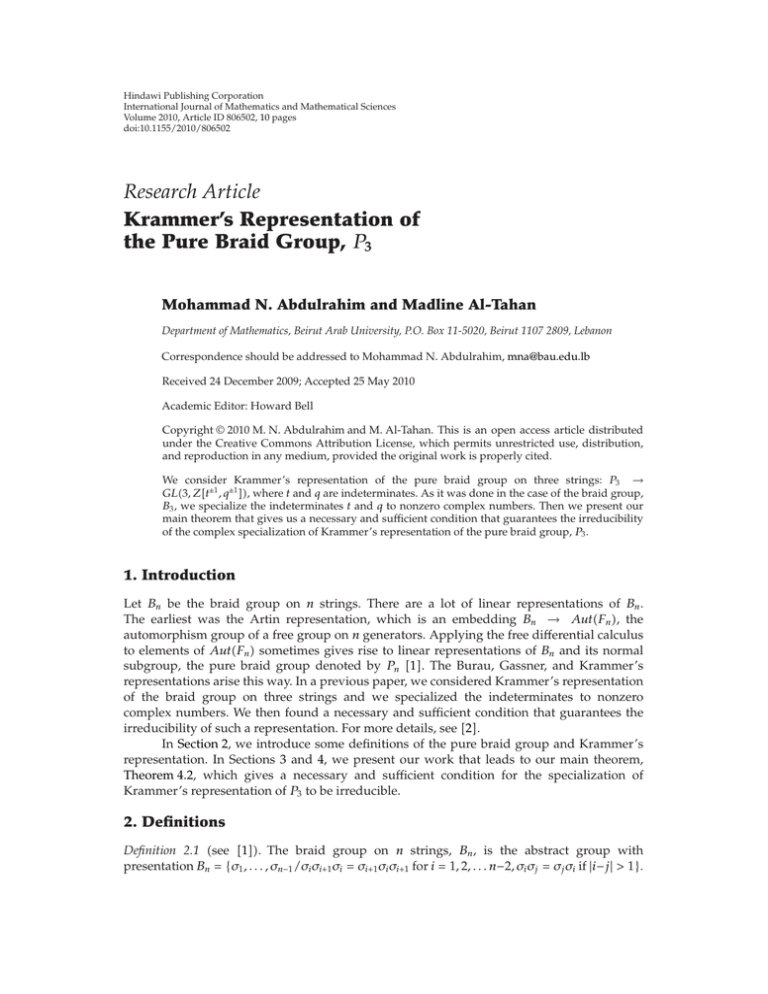Document 10456691
advertisement

Hindawi Publishing Corporation
International Journal of Mathematics and Mathematical Sciences
Volume 2010, Article ID 806502, 10 pages
doi:10.1155/2010/806502
Research Article
Krammer’s Representation of
the Pure Braid Group, P3
Mohammad N. Abdulrahim and Madline Al-Tahan
Department of Mathematics, Beirut Arab University, P.O. Box 11-5020, Beirut 1107 2809, Lebanon
Correspondence should be addressed to Mohammad N. Abdulrahim, mna@bau.edu.lb
Received 24 December 2009; Accepted 25 May 2010
Academic Editor: Howard Bell
Copyright q 2010 M. N. Abdulrahim and M. Al-Tahan. This is an open access article distributed
under the Creative Commons Attribution License, which permits unrestricted use, distribution,
and reproduction in any medium, provided the original work is properly cited.
We consider Krammer’s representation of the pure braid group on three strings: P3 →
GL3, Zt±1 , q±1 , where t and q are indeterminates. As it was done in the case of the braid group,
B3 , we specialize the indeterminates t and q to nonzero complex numbers. Then we present our
main theorem that gives us a necessary and sufficient condition that guarantees the irreducibility
of the complex specialization of Krammer’s representation of the pure braid group, P3 .
1. Introduction
Let Bn be the braid group on n strings. There are a lot of linear representations of Bn .
The earliest was the Artin representation, which is an embedding Bn → AutFn , the
automorphism group of a free group on n generators. Applying the free differential calculus
to elements of AutFn sometimes gives rise to linear representations of Bn and its normal
subgroup, the pure braid group denoted by Pn 1. The Burau, Gassner, and Krammer’s
representations arise this way. In a previous paper, we considered Krammer’s representation
of the braid group on three strings and we specialized the indeterminates to nonzero
complex numbers. We then found a necessary and sufficient condition that guarantees the
irreducibility of such a representation. For more details, see 2.
In Section 2, we introduce some definitions of the pure braid group and Krammer’s
representation. In Sections 3 and 4, we present our work that leads to our main theorem,
Theorem 4.2, which gives a necessary and sufficient condition for the specialization of
Krammer’s representation of P3 to be irreducible.
2. Definitions
Definition 2.1 see 1. The braid group on n strings, Bn , is the abstract group with
presentation Bn {σ1 , . . . , σn−1 /σi σi1 σi σi1 σi σi1 for i 1, 2, . . . n−2, σi σj σj σi if |i−j| > 1}.
2
International Journal of Mathematics and Mathematical Sciences
The generators σ1 , . . . , σn−1 are called the standard generators of Bn .
Definition 2.2. The kernel of the group homomorphism Bn → Sn is called the pure braid
group on n strands and is denoted by Pn . It consists of those braids which connect the ith
item of the left set to the ith item of the right set, for all i. The generators of Pn are Ai,j ,
−1
−1 −1
· · · σj−2
σj−1 .
1 ≤ i < j ≤ n, where Ai,j σj−1 σj−2 · · · σi1 σi2 σi1
Let us recall the Lawrence-Krammer representation of braid groups. This is a
representation of Bn in GLm, Zt±1 , q±1 AutV0 , where m nn − 1/2 and V0
is the free module of rank m over Zt±1 , q±1 . The representation is denoted by Kq, t.
For simplicity we write K instead of Kq, t. What distinguishes this representation
from others is that Krammer’s representation defined on the braid group, Bn , is a
faithful representation for all n ≥ 3 3. The question of whether or not a specific
linear representation of an abstract group is irreducible has always been a significant
question to answer, especially those representations of the braid group and its normal
subgroups. In a previous result, we determined a necessary and sufficient condition for the
specialization of Krammer’s representation of B3 to be irreducible 2. In our current work,
we apply Krammer’s representation on the normal subgroup of B3 , namely, the pure braid
group, P3 . Having done some computations, we succeed in establishing a necessary and
sufficient condition for the complex specialization of Krammer’s representation of P3 to be
irreducible.
Definition 2.3 see 3. With respect to {xi,j }1≤i<j≤n , the free basis of V0 , the image of each
Artin generator under Krammer’s representation is written as
⎧
⎪
tq2 xk,k1 ,
⎪
⎪
⎪
⎪
⎪
⎪
⎪
⎪
⎪
1 − q xi,k qxi,k1 ,
⎪
⎪
⎪
⎪
⎪
⎪
⎪
⎪
⎪
xi,k tqk−i1 q − 1 xk,k1 ,
⎪
⎪
⎪
⎪
⎪
⎨ Kσk xi,j tq q − 1 xk,k1 qxk1,j ,
⎪
⎪
⎪
⎪
⎪
⎪
⎪
⎪
xk,j 1 − q xk1,j ,
⎪
⎪
⎪
⎪
⎪
⎪
⎪
⎪
⎪xi,j ,
⎪
⎪
⎪
⎪
⎪
⎪
⎪
⎩x tqk−i q − 12 x
,
i,j
k,k1
i k, j k 1;
j k, i < k;
j k 1, i < k;
i k, k 1 < j;
2.1
i k 1, k 1 < j;
i < j < k or k 1 < i < j;
i < k < k 1 < j.
Using the Magnus representation of subgroups of the automorphisms group of free
group with nn − 1/2 generators, we determine Krammer’s representation Kq, t : P3 →
GL3, Zt±1 , q±1 . Here Zt±1 , q±1 is the ring of Laurent polynomials on two variables. The
images of the generators under Krammer’s representation are given by
International Journal of Mathematics and Mathematical Sciences
⎛
t2 q 4
0
⎜ 2 3
⎜
KA1,2 ⎝t q q − 1
q
tq q − 1 1 − q
⎛
1 − q q2 q 1 − q
⎜
KA2,3 ⎜
q
⎝ 1−q
0
0
⎛
0
3
⎞
⎟
q 1−q ⎟
⎠,
1 − q q2
⎞
tq3 q − 1
⎟
t2 q4 q − 1 ⎟
⎠,
t2 q 4
2.2
2 ⎞
1 − q − tq q − 1
q
q q−1
⎜
⎟
⎜
⎟
t
⎜
⎟,
KA1,3 ⎜
2
3
2
2
⎟
−tq
q
−
1
m
tq
tq
−
q
1
−
q
−
1
q
⎝
⎠
tq 1 − q
tq q − 1 1 − q tq2
n
where
4
m −1 q 2 − 2q q2 t q − 1 q2 1 − q 1 q q − 1 t2 ,
n 1 q q − 1 1 t q − 1 −1 q − tq2 .
2.3
Specializing t and q to non zero complex numbers, we consider the complex linear
representation Kq, t : P3 → GL3, C. We show that the only non zero invariant subspace
under the action of specialization of Krammer’s representation of P3 coincides with the
vectorspace C3 . Here, we regard M3 C as acting from the left on column vectors so that
eigenvectors and invariant subspaces lie in C3 .
3. Sufficient Condition for Irreducibility
In this section, we find a sufficient condition for the irreducibility of Krammer’s representation of the pure braid group on three strings P3 .
Theorem 3.1. For q, t ∈ C∗ 2 , Krammer’s representation Kq, t : P3 → GL3, C is irreducible
1, tq3 /
1, t /
− 1, q /
1, tq /
1, and tq2 /
− 1.
if t2 q3 /
Proof. For simplicity, we write Kα instead of Kq, tα, where α ∈ P3 . Suppose, to get
contradiction, that Kq, t : P3 → GL3, C is reducible; then there exists a proper nonzero
invariant subspace S, where the dimension of S is either 1 or 2. We will show that a
contradiction is obtained in each of these cases.
Assume that dimension of S is 1:
The subspace S has to be one of the following subspaces: e1 , e2 , e3 , e1 ue2 , e2 ue3 ,
e1 ue3 , e1 ue2 ve3 , where u, v are non zero complex numbers.
Case 1 S e1 . Since e1 ∈ S, it follows that A1,2 e1 ∈ S which implies that t2 q3 q − 1 0,
a contradiction.
4
International Journal of Mathematics and Mathematical Sciences
Case 2 S e2 . Since e2 ∈ S, it follows that A1,2 e2 ∈ S which implies that 1 − q 0, a
contradiction.
Case 3 S e3 . Since e3 ∈ S, it follows that A1,2 e3 ∈ S which implies that q1 − q 0, a
contradiction.
Case 4 S e1 ue2 , u / 0. Since e1 ue2 ∈ S, it follows that A1,2 e1 ue2 ∈ S. This implies
that
⎛ ⎞
1
⎟
⎜ ⎟
⎜ 2 3
⎜ t q q − 1 qu ⎟ m⎜u⎟,
⎠
⎝ ⎠
⎝
0
tq q − 1 1 − q u
⎛
t2 q 4
⎞
3.1
where m is a complex number. Solving this system of equations implies that tq − 1tq2 1 0, which is a contradiction to the hypothesis.
Case 5 S e2 ue3 , u / 0. Since e2 ue3 ∈ S, it follows that A2,3 e2 ue3 ∈ S. This implies
that
⎞
⎛ ⎞
⎛ 0
q 1 − q tq3 q − 1 u
⎟
⎜ ⎟
⎜
2
4
⎜ q t q q − 1 u ⎟ m⎜ 1 ⎟ ,
⎠
⎝ ⎠
⎝
2 4
u
tq u
3.2
where m is a complex number. By solving this system of equations, we get that tq − 1tq2 1 0, which is a contradiction.
Case 6 S e1 ue3 , u / 0. Since e1 ue3 ∈ S, it follows that A1,2 e1 ue3 ∈ S. This implies
that
⎛
⎞
⎛ ⎞
t2 q 4
1
⎜ 2 3
⎜ ⎟
⎟
⎜ t q q − 1 q 1 − q u ⎟ m⎜ 0 ⎟ ,
⎝
⎠
⎝ ⎠
2
u
tq q − 1 1 − q q u
3.3
where m is a complex number. By solving this system of equations, we get that tq − 1tq2 1tq2 q − 1 0.
0. This implies that tq2 q−1 0. That is, tq2 1−q.
By our hypothesis, tq−1tq2 1 /
Also, we have that A2,3 e1 ue3 ∈ S. This implies that
⎞
⎛ ⎞
1
1 − q q2 tq3 q − 1 u
⎟
⎟
⎜
⎜
⎜ 1 − q t2 q4 q − 1 u ⎟ n⎜ 0 ⎟,
⎠
⎝ ⎠
⎝
⎛
tq u
2 4
u
3.4
International Journal of Mathematics and Mathematical Sciences
5
where n is a complex number. By solving this system of equations, we get that t2 q3 −1. This
means that
t2 q3 tq tq2 tq 1 − q tq − tq2 tq − 1 q.
3.5
This implies that qt 1 0, which contradicts the hypothesis.
Case 7 S e1 ue2 ve3 , u, v /
0. Since e1 ue2 ve3 ∈ S, it follows that A1,2 e1 ue2 ve3 ∈
S. This implies that
⎛ ⎞
1
⎜
⎟
⎜ ⎟
2
3
⎜
⎟ m⎜u⎟,
t q q − 1 qu q 1 − q v
⎝
⎠
⎝ ⎠
2
v
tq q − 1 1 − q u 1 − q q v
⎛
t2 q 4
⎞
3.6
where m is a complex number. Since A2,3 e1 ue2 ve3 ∈ S, it follows that
⎞
⎛ ⎞
1
1 − q q2 q 1 − q u tq3 q − 1 v
⎟
⎜ ⎟
⎜
2
4
⎟ n⎜u⎟,
⎜
1 − q qu t q q − 1 v
⎠
⎝ ⎠
⎝
2 4
v
tq v
⎛
3.7
where n is a complex number. Solving these two system of equations, we get that m n t2 q4 . Also, we have that
q t2 q 3 − 1 u q q − 1 v t 2 q 3 q − 1 ,
3.8
q − 1 u t2 q4 − q2 q − 1 v tq q − 1 ,
3.9
q 1 − q u tq3 q − 1 v t2 q4 − q2 q − 1,
q t2 q3 − 1 u − t2 q4 q − 1 v 1 − q.
3.10
3.11
Substracting 3.11 from 3.8, we get that q1 t2 q3 v 1 t2 q3 . Here, we have 2 cases
whether or not 1 t2 q3 is zero.
If 1 t2 q3 0, then we rewrite 3.8, 3.9, 3.10, and 3.11 to become as follows:
2qu − q q − 1 v q − 1,
q − 1 u − q2 1 v tq q − 1 ,
3.13
q 1 − q u tq3 q − 1 v − q2 1 .
3.14
3.12
6
International Journal of Mathematics and Mathematical Sciences
Multiplying 3.13 by q and adding it to 3.14 we get that
q tq3 − tq2 − q2 − 1 v tq3 − tq2 − q2 − 1.
3.15
0. Thus v 1/q. Substituting
A simple computation shows that tq3 − tq2 − q2 − 1 /
v 1/q in 3.12, we get that u q − 1/q. Substituting u and v in 3.14, we get that
tq2 tq − 2. Having that t2 q3 −1 implies that t2 q3 tqtq2 tqtq − 2. This implies that
tq − 12 0 which contradicts the hypothesis.
0. Then v 1/q and u q − 1/q by 3.8. Substituting u
This means that 1 t2 q3 /
and v in 3.9, we get that tq − 1tq2 1 0, which contradicts the hypothesis.
Assume that dimension of S is 2:
Easy computations show that the subspace S cannot be in the form S ei , ej or S ei j /
k.
uej , ek for i /
0.
It suffices to consider only the case S e1 ue2 , e1 ve3 , where u, v /
Since e1 ue2 ∈ S, it follows that A1,2 e1 ue2 ∈ S and so
⎛
t2 q 4
⎞
⎜ 2 3
⎟
⎜ t q q − 1 qu ⎟ ∈ S.
⎝
⎠
tq q − 1 1 − q u
3.16
Also, we have that e1 ve3 ∈ S,then A1,2 e1 ve3 ∈ S, and so
⎛
⎞
t2 q 4
⎜ 2 3
⎟
⎜ t q q − 1 q 1 − q v ⎟ ∈ S.
⎝
⎠
2
tq q − 1 1 − q q v
3.17
This implies that q−q2 v−que2 1−qq2 vq−1ue3 ∈ S. Note that q−q2 v−qu
and 1 − q q2 v q − 1u cannot be both zeros. Assume then that q − q2 v − qu / 0.
Having that ue2 −ve3 ∈ S, we get that {u1−qq2 vq−1uvq−q2 v−qu}e3 ∈ S
and so
u qv u − ve3 ∈ S.
3.18
If u qvu − v /
0, then e3 ∈ S and thus S is the whole space. Now if u qvu − v 0,
then we have 2 cases: u −qv and u v:
⎛
⎞
⎛ ⎞
0
0
⎜ 2 3⎟
⎜ ⎟
⎟
⎜
⎟
let u −qv. Since⎜
⎝q⎠ ∈ S, it follows that⎝t q ⎠ ∈ S.
1
t2 q 2
3.19
International Journal of Mathematics and Mathematical Sciences
7
On the other hand, we have that
⎞
⎛ ⎞ ⎛
0
q − 1 tq − 1
⎜ ⎟ ⎜
⎟
2 2
⎟ ⎜
⎟
q−2 A2,3 ⎜
⎝q⎠ ⎝ 1 t q q − 1 ⎠ ∈ S.
1
t2 q 2
⎛
Substracting 3.19 from 3.20 we get that ⎝
q−1tq−1
1−t2 q2
3.20
⎞
⎠ ∈ S.
0
This means that
q − 1 tq − 1 e1 1 − t2 q2 e2 ∈ S.
3.21
e1 − qve2 ∈ S.
3.22
We also have that
Solving 3.21 and 3.22, we get that 1 tq q1 − qve2 ∈ S.
If 1 tq q1 − qv /
0, we are done. Otherwise, we have that v tq 1/qq − 1
and u −qv tq 1/1 − q. On the other hand, we have that
⎛ ⎞
1
⎜ ⎟
⎜u⎟ ∈ S
⎝ ⎠
0
⎛
1−q
⎞
⎟
⎜
⎟
then ⎜
⎝1 tq⎠ ∈ S.
0
3.23
Also, we have that
⎞
1 − q 1 q2 tq2
⎟ ⎜
⎟
⎜
2
2
⎟ ⎜
⎟
A2,3 ⎜
⎝1 tq⎠ ⎝ 1 q tq − q ⎠ ∈ S.
0
0
⎛
1−q
⎞
⎛
3.24
Solving 3.23 and 3.24 implies that q1 t1 tq2 e2 ∈ S and thus e2 ∈ S. Hence
SC .
Let u v. Since e2 − e3 ∈ S, it follows that A2,3 e2 − e3 ∈ S. That is, we have that
3
⎞
q − 1 −1 − tq2
⎜
⎟
⎜ 1 − t2 q3 q − 1 ⎟ ∈ S.
⎠
⎝
2 3
−t q
⎛
3.25
8
International Journal of Mathematics and Mathematical Sciences
We also have that
⎛
0
⎞
⎜ 2 3⎟
⎜ t q ⎟ ∈ S.
⎝
⎠
2 3
−t q
3.26
Substracting 3.26 from 3.25, we get that
q − 1 −1 − tq2 e1 1 − t2 q4 e2 ∈ S.
3.27
e1 ve2 ∈ S.
3.28
Also we have that
Solving 3.27 and 3.28, we get that {1 tq2 1 − tq2 vq − 1}e2 ∈ S. If 1 − tq2 vq − 1 0, then we get that u v tq2 − 1/q − 1.
Now we have that e1 ue2 ∈ S and so
⎞
q − 1 1 q2 − tq3
⎜ 2
⎟
⎜ tq − 1 1 q2 − tq3 ⎟ ∈ S.
⎠
⎝
⎛
3.29
0
We also have that
⎞
q − 1 1 q2 − tq3
⎟ ⎜
⎜ 2
⎟
2
3 ⎟
⎟ ⎜
A2,3 ⎜
⎝tq − 1⎠ ⎝ −q q − 1 tq ⎠ ∈ S.
0
0
⎛
q−1
⎞
⎛
3.30
Substracting 3.30 from 3.29, we get that q1 − tqtq3 − 1e2 ∈ S and so e2 ∈ S. Thus
SC .
3
Next, we find a necessary condition that guarantees the irreducibility of the complex
specialization of Krammer’s representation of P3 .
4. Necessary Condition for Irreducibility
We present the following theorem.
Theorem 4.1. For q, t ∈ C∗ 2 , Krammer’s representation Kq, t : P3 → GL3, C is reducible if
one of the following conditions is satisfied:
1 t2 q3 1,
2 tq3 1,
International Journal of Mathematics and Mathematical Sciences
9
3 t −1,
4 q 1,
5 tq 1,
6 tq2 −1.
Proof. Notice that the first three conditions followed from the reducibility on B3 . Under each
of the last three conditions of our hypothesis, we find a proper nonzero invariant subspace
under the action of complex specialization of Krammer’s representation of P3 . Recall that
the matrices KA1,2 , KA2,3 , and KA1,3 that will be used in the proof are those given in
Definition 2.3.
Proof of 4 (q 1). We have that
⎞
⎛2
t 0 0
⎟
⎜
⎟
KA1,2 ⎜
⎝ 0 1 0⎠,
0 0 1
⎛
1 0 0
⎞
⎟
⎜
⎟
KA2,3 ⎜
⎝0 1 0 ⎠,
0 0 t2
⎞
⎛
1 0 0
⎜ 2 ⎟
⎟
KA1,3 ⎜
⎝0 t 0⎠.
0 0 1
4.1
We take the invariant subspace as the one generated by e1 1, 0, 0.
Proof of 5 (tq 1). We have that
⎛
q2
⎜ KA1,2 ⎜
⎝q q − 1
0
q
0
⎞
⎟
q 1−q ⎟
⎠,
q−1
1 − q 1 − q q2
⎞
⎛
1 − q q2 q 1 − q q2 q − 1
⎜
⎟
KA2,3 ⎜
q
q2 q − 1 ⎟
⎠,
⎝ 1−q
2
0
0
q
⎞
⎛
q
q q−1
1 − q q2
⎜ 2
2 ⎟
⎟
KA1,3 ⎜
⎝− q − 1 1 2q q − 1 −q q − 1 ⎠.
1−q
q−1
4.2
q
We take the invariant subspace as the one generated by m 0, q, 1T . More precisely,
we have that
KA1,2 m m,
KA2,3 m q2 m,
KA1,3 m q2 m.
4.3
10
International Journal of Mathematics and Mathematical Sciences
Proof of 6 (tq2 −1). We have that
⎛
1
⎜
KA1,2 ⎜
⎝ 1 tq
0
q
⎞
0
⎟
q 1−q ⎟
⎠,
−1 − tq 1 − q 1 − q q2
⎞
⎛
1 − q q2 q 1 − q q 1 − q
⎟
⎜
q
q−1 ⎟
KA2,3 ⎜
⎠,
⎝ 1−q
0
0
1
⎞
⎛
q
q q−1
q q−1
⎜
2 ⎟
2
⎟
KA1,3 ⎜
⎝q − 2 − tq q − 2q 2 q − 1 ⎠.
tq 1
q−1
4.4
q
We take the invariant subspace as the one generated by m −q, 1, 0T . More precisely,
we have that
KA1,2 m m,
KA2,3 m q2 m,
KA1,3 m m.
4.5
Combining Theorems 3.1 and 4.1, we obtain our main theorem.
Theorem 4.2. For q, t ∈ C∗ 2 , Krammer’s representation Kq, t : P3 → GL3, C is irreducible
1, tq3 /
1, t /
− 1, q /
1, tq /
1, and tq2 /
− 1.
if and only if t2 q3 /
References
1 J. S. Birman, Braids, Links, and Mapping Class Groups, Annals of Mathematics Studies, no. 8, Princeton
University Press, Princeton, NJ, USA, 1974.
2 M. N. Abdulrahim and M. Al-Tahan, “Complex specializations of Krammer’s representation of the
braid group, B3 ,” Journal of Mathematics and Statistics, vol. 4, no. 4, pp. 213–216, 2008.
3 D. Krammer, “Braid groups are linear,” Annals of Mathematics, vol. 155, no. 1, pp. 131–156, 2002.






